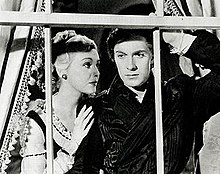Tyrone Power
[4] Though largely a matinee idol in the 1930s and early 1940s and known for his striking good looks, Power starred in films in a number of genres, from drama to light comedy.
His father suffered a heart attack in December 1931, dying in his son's arms, while preparing to perform in The Miracle Man.
In these years he starred in romantic comedies such as Thin Ice and Day-Time Wife, in dramas such as Suez, Blood and Sand, Son of Fury: The Story of Benjamin Blake, The Rains Came and In Old Chicago; in musicals Alexander's Ragtime Band, Second Fiddle, and Rose of Washington Square; in the westerns Jesse James (1939) and Brigham Young; in the war films A Yank in the R.A.F.
Jesse James was a very big hit at the box office, but it did receive some criticism for fictionalizing and glamorizing the famous outlaw.
The great Hollywood swordsman, Basil Rathbone, who starred with him in The Mark of Zorro, commented, "Power was the most agile man with a sword I've ever faced before a camera.
He reported to the United States Marine Corps for training in late 1942, but was sent back, at the request of 20th Century-Fox, to complete one more film,[citation needed] Crash Dive, a patriotic war movie released in 1943.
He had already logged 180 solo hours as a pilot before enlisting, so he was able to do a short, intense flight training program at Naval Air Station Corpus Christi, Texas.
From there, he flew missions carrying cargo in and wounded Marines out during the Battles of Iwo Jima (February to March 1945) and Okinawa (April to June 1945).
[21] Other than re-releases of his films, Power was not seen on screen again after his entry into the Marines until 1946, when he co-starred with Gene Tierney, John Payne and Anne Baxter in The Razor's Edge, an adaptation of W. Somerset Maugham's 1944 novel of the same title.
Darryl F. Zanuck was reluctant for Power to make the movie because his handsome appearance and charming manner had been marketable assets for the studio for many years.
The movie was directed by Edmund Goulding, and though it was a failure at the box-office, it was one of Power's favorite roles for which he received some of the best reviews of his career.
After making a couple of light romantic comedies reuniting him with two actresses under contract to 20th Century-Fox, That Wonderful Urge with Gene Tierney and The Luck of the Irish (both 1948) with Anne Baxter.
In 1950, he traveled to England to play the title role in Mister Roberts on stage at the London Coliseum, bringing in sellout crowds for twenty-three weeks.
[25] Power next appeared in Diplomatic Courier (1952), a Cold War spy drama directed by Henry Hathaway which received very modest reviews.
He turned it down (Richard Burton was cast instead) and on 1 November 1952, he left on a ten-week national tour with John Brown's Body, a three-person dramatic reading of Stephen Vincent Benét's narrative poem, adapted and directed by Charles Laughton, featuring Power, Judith Anderson and Raymond Massey.
In the same year, Power filmed King of The Khyber Rifles, a depiction of India in 1857, with Terry Moore and Michael Rennie.
[citation needed] Fox now gave Power permission to seek his own roles outside the studio, on the understanding that he would fulfill his fourteen-film commitment to them in between his other projects.
Also in 1953, actress and producer Katharine Cornell cast Power as her love interest in the play The Dark is Light Enough, a verse drama by British dramatist Christopher Fry set in Austria in 1848.
His performance in Julian Claman's A Quiet Place, staged at the National Theater, Washington, at the end of 1955 was warmly received by the critics.
), shot in Great Britain, and John Ford's Rising of the Moon (narrator only), which was filmed in Ireland, both for Copa Productions.
Writing for the National Post in 2002, Robert Fulford commented on Power's "superb performance" as "the seedy, stop-at-nothing exploiter of women".
Power was one of Hollywood's most eligible bachelors until he married French actress Annabella (born Suzanne Georgette Charpentier) on July 14, 1939.
She explained that the war clouds over Europe made her unhappy and irritable, and to get her mind off her troubles, she began accepting stage work, which often took her away from home.
[33] In 1946, Power and friend Cesar Romero, accompanied by former test pilot, James Denton, a 20th Century Fox executive, and fellow war veteran John Jefferies as navigator, embarked on a goodwill tour throughout South America where they met, among others, Juan and Evita Perón in Argentina.
Buck stated in his autobiography[37] that Power had a photographic mind, was an excellent pilot, and genuinely liked people.” They flew with a crew to various locations in Europe and South Africa, often mobbed by fans when they hit the ground.
[33] Power and Christian were married in Rome on January 27, 1949, in the Church of Santa Francesca Romana, with an estimated 8,000 to 10,000 screaming fans outside.
[44] In September 1958, Power and his wife Deborah traveled to Madrid and Valdespartera, Spain, to film the epic Solomon and Sheba, directed by King Vidor and costarring Gina Lollobrigida.
In the foreword to Dennis Belafonte's The Films of Tyrone Power, King wrote: "Knowing his love for flying and feeling that I had started it, I flew over his funeral procession and memorial park during his burial, and felt that he was with me.
His grave is marked with a gravestone in the form of a marble bench containing the masks of comedy and tragedy with the inscription "Good night, sweet prince."
On the 50th anniversary of his death, Power was honored by American Cinematheque with a weekend of films and remembrances by co-stars and family as well as a memorabilia display at the Egyptian Theatre in Los Angeles from November 14–16, 2008.










